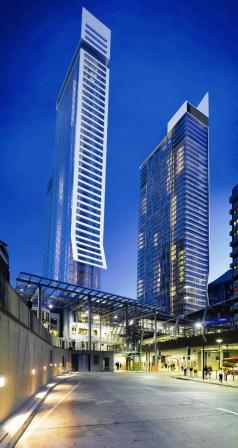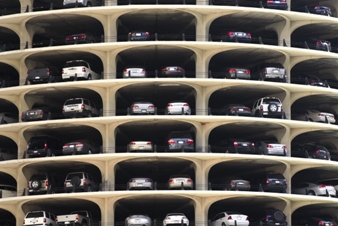In March this year, the National Roads and Motorists Association (NRMA) predicted that families living in Sydney’s western suburbs could expect annual fuel bills up to $2,000, were tense events in the Middle East to continue. At the time Commsec economist, Savanth Sebastian, was quoted in The Daily Telegraph, suggesting that, “Petrol is the single biggest purchase by households on a weekly basis.”
Why might such observations be of interest to built environment profes sionals? Because, as Alex Wilson, founder and executive editor of the venerable trade journal, Environmental Building News, explains, “for [the] average building, the transportation energy use exceeds the building energy use by 30 per cent.”
Transportation energy intensity of a building is, Alex explains, “the amount of energy associated with get ting people to and from that building, whether they are commuters, shop pers, vendors, or homeowners.” An issue recently the focus of the Planning Institute of Australia (PIA), who in December 2010, published a special Peak Oil issue of their national journal, Australian Planner, entitled "Cities and Oil Vulnerability.”
Derived from finite fossil fuels, transport energy in the form of petrol and diesel, is drawn from declining reserves, often in highly volatile geo- political regions. And even when oil is sourced from stable locations like the United States, its extraction has now become highly complex and danger ous. As clearly demonstrated by the death of 11 workers, and release of 800 million litres of oil into the Gulf of Mexico from BP’s Deepwater Horizon oil spill catastrophe. Not to mention Australia’s own Montara spill, which poured oil into an estimat ed 6,000 square kilometres of the Timor Sea for 74 days.
 Image: The planned TOD at Chatswood in Sydney, courtesy Ivolve Images
Image: The planned TOD at Chatswood in Sydney, courtesy Ivolve Images
Transit Oriented Development (TOD), alternatively know as Transport Oriented Design, is one way the built environment can ame liorate the high impact of humankind’s excessive travel for work and leisure. ‘Location Efficiency’ another term, interchangeable for TOD, usually results in reduced car usage, reduced car ownership, increased use of public transport, reduced carbon footprint, increased local business activity and more effi cient use of existing infrastructure," said Colliers International research analyst, Lachlan Walker, in an article by the Brisbane Times.
The Australian Tourism and Transport Forum (TTF) see TODs as a key response to our sprawling cities, as they increase urban densities along transport corridors, particularly public transport corridors. “By creating pedestrian-oriented medium to high- density mixed-use spaces around public transport hubs, this type of development simultaneously con strains urban sprawl and encourages public transport use.”
However, the TTF are quick to point out “that adequate transport infrastructure — and good services — are a prerequisite for this kind of development.” And that may be one of the reasons why Australia has been slow to fully embrace Transit Oriented Development. In many Australia cities, roads, more often than not, take precedence (and fund ing dollars), when compared to pub lic transport.
Peter Newman, environmental sci entist, Western Australian academic, and author of several books on auto mobile dependence, referred to our national reluctance to get behind TOD, in a speech quoted by the Sydney Morning Herald. “A Sydney developer is going to Perth to put $90 million into transit-oriented develop ment around the [rail] stations.”
Why? One reason that Newman offers is that Western Australia has moved from spending for every $5 on roads and $1 on public transport, to $1 on roads for every $5 on public transport. That Sydney developer may just know on what side their bread is buttered. For instance, the Brisbane Times noted a PRDnationwide report in 2010, indicating that “property val ues in Brisbane suburbs with a train station jumped 10.3 per cent between January and December last year. These suburbs outperformed those with no rail service, which achieved 7.7 per cent growth in the same year.”
This backs up Tourism and Transport Forum analysis which cites research into property prices in the USA that found, “properties located near a transit station experienced high values than comparable properties without transit facilities.” 
Staying in Queensland for the moment, that state’s Department of Local Government and Planning (DLGP) observe that transit oriented development is a key policy of their South East Queensland Regional Plan 2009-2031, because it “supports the delivery of a range of government priorities relating to climate change, housing affordability, congestion, health and physical activity.” The plan has a complete chapter on inte grated land use and transport plan ning, which includes the observation that such development ”reduces the need for travel; results in shorter journeys; provides safer and easier access to jobs, schools and services; supports more efficient land and existing infrastructure use; and main tains the environmental benefits of compact development.”
Such new found enthusiasm for transit oriented development shows the very significant impact the car has had on Australian society. Long before we became a nation ranked fourth in the world for motor vehicles per capita, urban expansion naturally occurred along train and tram lines. Cars, heavily marketed for their per ceived value of personal freedom, helped drive housing development well away from transport hubs. Car dependent suburban shopping malls and industrial/commercial centres exacerbated the problem of homes isolated from recreation facilities, schools, hospitals, libraries, and other useful services. That vision of personal freedom has proven illusionary.
The Tourism and Transport Forum reference government estimates that traffic congestion cost Australia $12.1 billion in 2009, growing to $20.4 billion by the time we reach 2020. The Australian Sustainable Built Environment Council (ASBEC) report ’Cities for the Future’ forecasts for some urban cen tres average trip speeds would decrease by up to 13 per cent, with a corresponding 25 per cent increase in travel time compared to current commutes. And, without interven tion, land transport greenhouse gas emissions would rise 46 per cent.
Although not technically a pure Transit Oriented Development, the Lilyfield Housing Redevelopment in inner western Sydney, does indicate the type of design that suits the TOD strategy. When 88 new apartments replaced 40 ageing units it became the first social housing scheme in Australia to earn Green Star certifica tion from the Green Building Council of Australia. One aspect of the project which helped architects HBO+EMTB garner the 5 Stars for Multi Unit Residential rating was that they eschewed the inclusion of off-street parking for the redevelopment. Made possible by nearby bus routes and a Metro Light Rail station just a 400 metre walk way.
This is half of the 800 metres that is deemed the optimum maximum dis tance that new housing developments should be from transport hubs, according to extensive research into the travel habits of urban dwellers. Coincidentally, Kevin Warrell, CEO of Metro Light Rail, once pointed out to the Sydney Morning Herald that a study of a London tramway found car usage by people living within 800 metres of new tram stops dropped from 59 per cent to 32 per cent on weekdays.
Whilst enhanced walkability to a high frequency public transport node is one core facet of transit oriented development, it is not the sole defin ing characteristic. Queensland’s Department of Local Government and Planning suggest TOD’s benefit from: rapid transit services, a mix of residential, retail, commercial and community uses, high-quality public spaces and streets which are pedestri an and cyclist friendly, medium to high density development, and reduced rates of private car parking.
Victoria’s ‘Melbourne @ 5 million’ policy plan looks at the population implications for 2030, indicating that Government should be focusing on the creation of six new Central Activities Districts in Box Hill, Broadmeadows, Dandenong, Footscray, Frankston and Ringwood, that, “will reduce congestion and enable people to spend less time com muting to and from work and more time with their family.”
Also in Melbourne, albeit on a much smaller scale, are facilities such as Bike Park, an old nightclub con verted into purpose designed, secure bicycle parking, complete with show ers, just a few hundred metres from Flinders Street rail station.
Still on bikes, the Brisbane-based company, Penny Farthings, designs pushbike parking buildings ideally suited to Transit Oriented Developments. For example, their Green Pod is designed to be a solar powered, LED lit, self cleaning bike storage, with its own integrated solar hot water shower system and grey water treatment unit.
Space precludes us from listing other Australian TOD related proj ects, but the Tourism and Transport Forum’s position paper, ‘The Benefits of Transit Oriented Development,’ highlights additional local and interna tional examples.
Transit Oriented Development is not likely to be a panacea to all our urban ills, and it has its own coterie of critics, but should be considered a most useful arrow in a quiver of strategies to address many of the issues which do ail our cities.
We conclude with a recent study released by the US Environmental Protection Agency’s (EPA) Office of Sustainable Communities, called ‘Location Efficiency and Housing Type,’ which noted that, “the most effective way to reduce energy con sumption is to locate homes of all types in areas where households could replace some automobile use with transit use, leading to reductions of 39 to 50 percent in household energy use.” And went on to say, “Still greater gains are possible when the location- efficient homes and their cars are energy efficient.”

